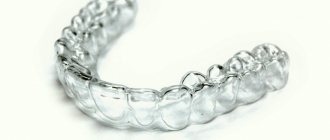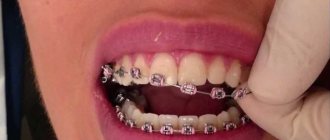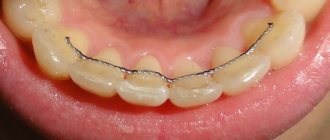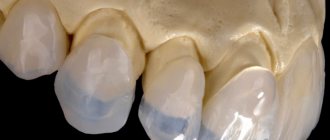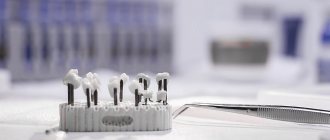In orthodontics, braces treatment is used to correct malocclusions.
This is a rather complex and lengthy process that requires more than one month of time. Dental guards, used after wearing braces, are one of the finishing touches of treatment. Why might you even need mouth guards after removing braces, because, in fact, once you finish wearing the braces, the results are obvious? Treatment of malocclusion is a rather complex problem in dentistry, and wearing special products to correct it is one of the initial stages of an orthodontist’s work. Artificially moved teeth may eventually return to their incorrect position. But how long do you wear mouthguards after braces are removed? In each case, the situation is individual, and only a doctor can determine the time you will spend with them.
In what cases are braces placed?
The very essence of such treatment is the forced alignment of the dentition - this is the first thing that those who doubt the need to install them need to know about braces. Only these systems guarantee a visual effect within 10–12 months and can work even in complex cases of twisted or crooked teeth in adults.
In what cases are braces placed? Common indications for installation are:
- broken bite;
- facial asymmetry;
- presence of tooth gaps;
- crooked or twisted teeth;
- previous jaw injuries or other pathologies that provoked temporomandibular anomalies (crunching and characteristic discomfort may be present when chewing);
- unevenness of the dentition - protruding or recessed individual teeth.
There are different types of braces for children and adults. Their choice is always a joint work of the treating orthodontist and the patient.
Whichever option you choose, our specialists will conduct a detailed consultation taking into account the goals and individual priorities of each patient. Depending on which teeth the braces are placed on (type of malocclusion), we will help you choose the best option, prepare you for the procedures, and carry out all installation work without discomfort, pain, or fear.
Which is better, a mouth guard or a wire retainer?
Both mouthguards and retainers give the same result, keeping the teeth in the correct position after treatment.
Retainers are cheaper than mouthguards, which often have to be made individually, but while wearing them, problems with maintaining hygiene may arise, and there is a need to regularly contact a specialist.
Mouth guards are easy to use, but require constant care and strict adherence to wearing rules. Only a specialist can tell which design is best for a particular patient.
Types of braces
The selection tactics begin with studying the differences and advantages of the types of braces. There is no single classification of them in orthodontics, but there is a conditional division according to three criteria.
- Depending on the material of the plate, it can be metal, ceramic, or sapphire. There are also plastic and gold structures, but the former are easy to paint and are not durable, while the latter are made only in Germany and require particularly painstaking work.
- Based on the installation method, systems are divided into internal (lingual, invisible) and external (classical).
- What are braces in terms of their design? Most systems consist of three main components. The base is a metal arc on which wing plates are strung through special grooves and glued to each tooth. Between the plate and the arc there is one more element - a ligature, a gasket. Classic designs are ligature; there are also non-ligature types of braces: they are thicker, but cover a smaller area of the tooth.
How to choose a bracket system. Review.
What you need to know about metal braces
Metal systems are highly durable. The experience gained in working with them is enormous, which is why installing such structures is cheaper. What are the characteristics of the best braces – metal structures?
- Price. We constantly have discounts and promotions when choosing such treatment - the cost of installation (with cleaning, removal) can start from 7-10 thousand rubles.
- Efficiency. Metal overlays provide a faster visual effect. Plus, in particularly difficult cases, only they can ensure high-quality alignment of the entire row, since they provide the highest pressure on each tooth.
- Ease of operation.
The only thing about metal structures that not everyone is happy with is that they are noticeable.
Ceramic bracket systems
Ceramic types of braces are not visible to the naked eye in photos or in real life.
They are chosen to match the color of the teeth. In terms of strength, durability/resistance to crumbling and cracking, ceramics are almost as good as metal. A big plus of ceramics is its smooth, matte surface. It adheres well to the tooth, serves without problems until the end of the treatment period, and does not glare in the sun, in the focus of the camera. The cost of ceramic systems is higher than metal ones, but their aesthetic effect is better.
Sapphire types of bracket systems
Sapphire types of bracket systems are made from artificial sapphire crystals. Unlike ceramic ones, sapphire structures are not matched to the color of the enamel; they are transparent, and therefore existing tooth defects are visible with them. They are recommended for people with a snow-white smile.
Artificial sapphire is durable, resistant to crumbling, it does not stain, and has a lighter structure, so it is easier to get used to lightweight structures. Plus they do not require complex care. The aesthetic effect in the photo and the prices of types of artificial sapphire braces will help you get a more accurate idea of the benefits of installing them.
Invisible braces
According to the method of fixation, all systems are divided into vestibular (external) and lingual. The latter are fixed on the back side of the teeth, they are completely invisible, hence another name - invisible.
Features of internal installation designs:
- production strictly according to an individual cast (sometimes 2-3 fittings are required for a perfect fit);
- absolute invisibility;
- more complex installation procedure (and corresponding cost of products);
- influence on diction (until the period of adaptation passes).
As evidenced by reviews from doctors about the pros and cons of lingual braces, the process of getting used to the system takes a little longer. But this does not prolong the wearing period - in all efficiency parameters, invisible brace systems are similar to visible ones. They can be made with metal, ceramic or sapphire plates.
Non-ligature systems
One of the trends in modern orthodontics and an increasingly frequent preference of our patients are non-ligating (self-ligating) lightweight structures. Such systems do not provide additional spacer between the metal arch and the wings glued to the tooth.
Fixation of structural elements is carried out thanks to a special locking technology - the quality of treatment (bite correction - why braces are needed) does not suffer. Among the advantages of non-ligature systems:
- simpler oral hygiene;
- convenient treatment regimen (in ligature systems, constant replacement of ligatures is required, with self-ligating braces there is less need to visit the doctor);
- quick effect (friction between the grooves and the arch is lower, the tooth is better fixed).
Alternative
After braces, other orthopedic devices are used to maintain the shape of teeth:
- Retainer. It is a non-removable wire structure that is attached to the teeth from the back side. The only inconvenience when using it is the need to visit a dentist for professional cleaning of molars: caries or tartar may form under the wire. Also, retainers cannot be removed or put back on your own if they come off.
- Plate. It is created based on a cast of the patient’s jaw. It consists of a plastic base that fits the upper palate and a metal plate that covers the problem teeth. Removable design, the main disadvantage of which is its unaesthetic appearance.
Retainer
Plate
Final table comparison of types of structures
| Type of design | Peculiarities | Price |
| Metal | Easy installation. Minimum cost. High efficiency. Noticeable. | The most affordable. |
| Ceramic | Matched to the color of the teeth. Unnoticeable. Durable. Effective due to good adhesion. | Lower than sapphire, lingual, non-ligated, but higher than metal ones. |
| Sapphire | Transparent. Almost invisible. Do not cause allergies. Durable. Suitable for snow-white teeth. | Higher than metal ones, not much higher than ceramics. |
| Lingual | Completely invisible. Effective treatment. Longer addiction. | Premium class |
| Self-ligating | Comfortable to wear. Do not require frequent visits to the doctor. Aesthetic. Can be made from different materials. Speed up treatment. | Premium class |
Popular questions
Can a mouthguard be used instead of braces?
Mouthguards are used to correct malocclusions, but they are not suitable for all clinical cases. Serious anomalies cannot be corrected with their help: this requires braces or a combined approach, in which plates are used only at the final stage of treatment.
The mouth guard is cracked, what should I use to seal it?
You should not try to repair or seal a cracked or chipped mouth guard yourself: a broken device can damage your teeth. If you find mechanical damage to the mouthguard, you must stop wearing it and consult your doctor.
Price of dental braces
The price of dental braces is determined individually, calculated for each jaw and most of all depends on two conditions - material, installation method. If the cost of treatment is critical for you, then give preference to budget metal systems. They are noticeable, but effective, look neat, and are easy to install.
A compromise aesthetic option is ceramics. Zuub constantly runs promotions where you can install systems for literally 20–50% of the average market cost of such structures.
Lingual (invisible) products belong to the “premium” class, but provide exceptional aesthetics of the result. Their cost today varies between 50+ thousand per jaw. The most expensive systems are self-ligating, non-ligating.
How much do mouth guards cost?
One of the few disadvantages of mouth guards is their high cost.
How much it will cost depends on the type of mouthguard:
- Standard mouthguards are a budget option. 1 record can be bought at a price of 800 rubles, the average price for such designs is about 1,500 rubles.
- Individual mouthguards. The initial price of one plate starts from 8,000 rubles, but the full cost of the device includes: diagnostics, creation of an impression, modeling of a mouthguard, and, if necessary, the creation of several sets. All these services can cost the patient 90,000 – 250,000 rubles.
Which braces are better?
The final decision about which braces are best for you or your child is always the result of an analysis of a set of factors and conditions. The choice depends on the condition of the tooth enamel, the degree of curvature of the teeth, the patient’s age, budget, and individual contraindications (for example, an allergy to metal).
What braces are best for adults?
Age is one of the key factors in selecting an effective treatment program. What braces are best for adults? As our experience shows, there can be several correct solutions:
- metal structures are optimal if the key condition is the cost of treatment;
- ceramics are optimal for business people who do not want to draw attention to a temporary structure; or allergy sufferers;
- People with high sensitivity of teeth, gums and mucous membranes should vote for an external self-ligating system - such braces are easier to tolerate in adulthood and give an excellent effect.
What braces are best for a teenager?
When choosing which braces are best for a teenager, you should rely on two non-financial factors: the age/character of the child and the degree of malocclusion. At an earlier age, classic metal braces are recommended for children. You can choose original ligatures for them - with a pattern, glowing in the dark, multi-colored. Young patients like this treatment format, plus the design of the onlays can be changed every 2-3 months.
When deciding which braces are best for a teenager, reviews from the attending physician about popular designs for a specific age category are indispensable. At an older age or for very shy children, ceramics are recommended. It is not visually striking, and, therefore, will not give rise to the development of complexes. The effect of treatment with ceramic structures on children’s/teenage teeth is excellent.
Invisible structures for a teenager are an ineffective solution, since his jaw is constantly changing and growing. Considering that such special structures are made strictly for specific jaw sizes, the child may simply outgrow them before the end of the therapy cycle.
Braces or aligners
How to use mouthguards correctly?
The mouth guards are worn over the entire jaw at the same time, like a case. The high-quality design fits comfortably and fits tightly around the teeth. For the first one and a half to two months after removing braces, you will have to wear the mouthguards for a long time - up to 22-24 hours a day, removing them only when eating or brushing your teeth.
Then they can be worn only at night and, finally, once every 2-3 weeks. The dentist can also give individual recommendations based on the case of a particular patient.
The difference between braces and choosing the best braces system: results
The conditions that determine the difference between different types of braces in terms of their attractiveness are numerous.
- Aesthetics. In descending order of aesthetic effect, a number of options can be arranged as follows: lingual, ceramic or sapphire external and metal structures.
- Easy to care for. It is easier to care for self-ligating systems than ligature ones; and vestibular than lingual. Although everything here is very individual.
- Reliability. The most durable materials are metal and ceramics. Which braces are better, ceramic or metal, must be decided based on price and specific indications.
- Price. Budget options - metal, plastic. But “Zuub” is an exception to the rule: promotions and discounts on premium solutions with ceramic and self-ligating structures are not uncommon.
- Ease of use. Non-ligature systems are easier and people get used to them faster. Lingual braces can affect diction - they will be distracting at first, but they are not visible to others.
The correct choice depends entirely on the significance of each factor given. Without an examination, we cannot state which option is right for you, but we know exactly where it is best to get braces in Moscow.
The Zuub Clinic works with all popular types of structures and offers competent assistance in choosing them. Our specialists will help you make the right decision on the price-quality ratio. Contact us, the first step - expert consultation - will be completely free for you and does not oblige you to anything.
If you have the symptoms described in this article, be sure to make an appointment at our clinic.
Don't self-medicate! Even the smallest problem, if not treated correctly, can significantly complicate your life.
By contacting us, you can be sure that:
- Get high-quality and free consultation .
- You will receive the best prices for treatment and the opportunity to receive a special promotional price.
- Only modern equipment and materials will be used.
- You will be treated by professional doctors with many years of experience.
- We offer treatment on credit or in installments. There is also the possibility of obtaining a tax deduction.
- We work seven days a week and without a lunch break, from 9 a.m. to 10 p.m.
+7 (495) 132-02-96
Make an appointment
Advantages of treating malocclusion with aligners by I.A. Butorina
- Irina Aleksandrovna Butorina is an experienced orthodontist with many years of experience
- You will be able to undergo treatment using high quality aligners
- Comprehensive diagnostics and individual approach to treatment
- Convenient location and operating hours of the clinic
Correcting the bite with aligners is by far the most progressive method of orthodontic treatment. In America and Europe, transparent aligners have already replaced traditional braces. To make an appointment with a certified orthodontist, you can call or email
Reviews
Lyudmila, Penza: Recently my braces were removed and I was given a mouth guard as a retainer. I wear it only at night - I can’t wear it during the day due to the nature of my profession, but all the teeth are in place, there is no curvature.
Victor, Saratov: They straightened my son’s teeth with braces - he was terribly embarrassed. We talked with the dentist, and he allowed me to order mouth guards for the final stage of treatment. It turned out to be expensive, but we were pleased: he is comfortable to wear, and they are not visible at all, so he enjoys going to school with them.
Evgenia, Moscow: When I first put on mouth guards after braces, I had a slight lisp at first, but it quickly went away. I carried it for 4 months instead of the prescribed two, just in case. I was terribly tired of constantly brushing them, but otherwise there was no discomfort, and all my teeth were straight.
When wearing mouthguards, the main thing is a systematic approach and compliance with the rules of care. In this case, the device will help you go through the retention period quickly and without any discomfort.
